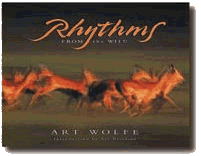Part Three

For the past two and a half decades, Wolfe's photographs have been recognized worldwide for their mastery of color, composition, perspective and expressions on wild animals' faces. "His eye contact with animals is phenomenal," says Sleeper, "He talks to the animals, and he has such a presence. He seems to captivate them and look into their soul. You can feel the connection."
His approach to photography is based both on his training in the arts and his love of the environment. As a child, he spent many weekends camping with his family in the Cascades along Nason Creek, exploring the Oregon coast or taking day trips to Mount Rainier. While a college student, he spent his weekends hiking the Washington coast, his summers climbing peaks in the Cascades or Olympics.
"Forest, mountain and ocean were the themes that defined my travel experiences well into my young adulthood," he says. "For the most part, they form what I am today.
"I love the process of creating a photo that may be a very intimate experience for me," he goes on. "If I'm successful, that photo could conceivably be seen by millions of people. I love the communication factor of that process."
His art background heavily influences everything he does, from his photography to the way he decorates his home. "Everything is cloaked with a strong sense of composition, a sense of light and direction from light, a sensitivity to textures and shapes and line, which I learned from painting," he says. "All the elements of design run through my photos. I think it's given me an advantage."
Another advantage is his ongoing desire to seek out new approaches to what he does. After spending most of his early career shooting the sharpest, most well-defined photographs of wildlife possible, he switched gears in the early 1990s, using long exposures and panning his camera to create impressionistic imagery.
His 1997 book, Rhythms of the Wild, marked a new development in his work-capturing movement in a far more painterly fashion than anything he had done before. " I came to photography as a painter with a fine-arts background," he says. "The pictures in this book reflect those origins as I spiral ahead with my ongoing work in photography." Using a tripod for long exposures of at least one or two seconds, he turns running zebras into a swirling pattern of black and white lines, a wave off the Hawaiian coast into an image that you would swear came off the end of a paintbrush.
Controversy Over Digital Images
Recent Books by Art Wolfe
Send a letter to the editor at columns@u.washington.edu.